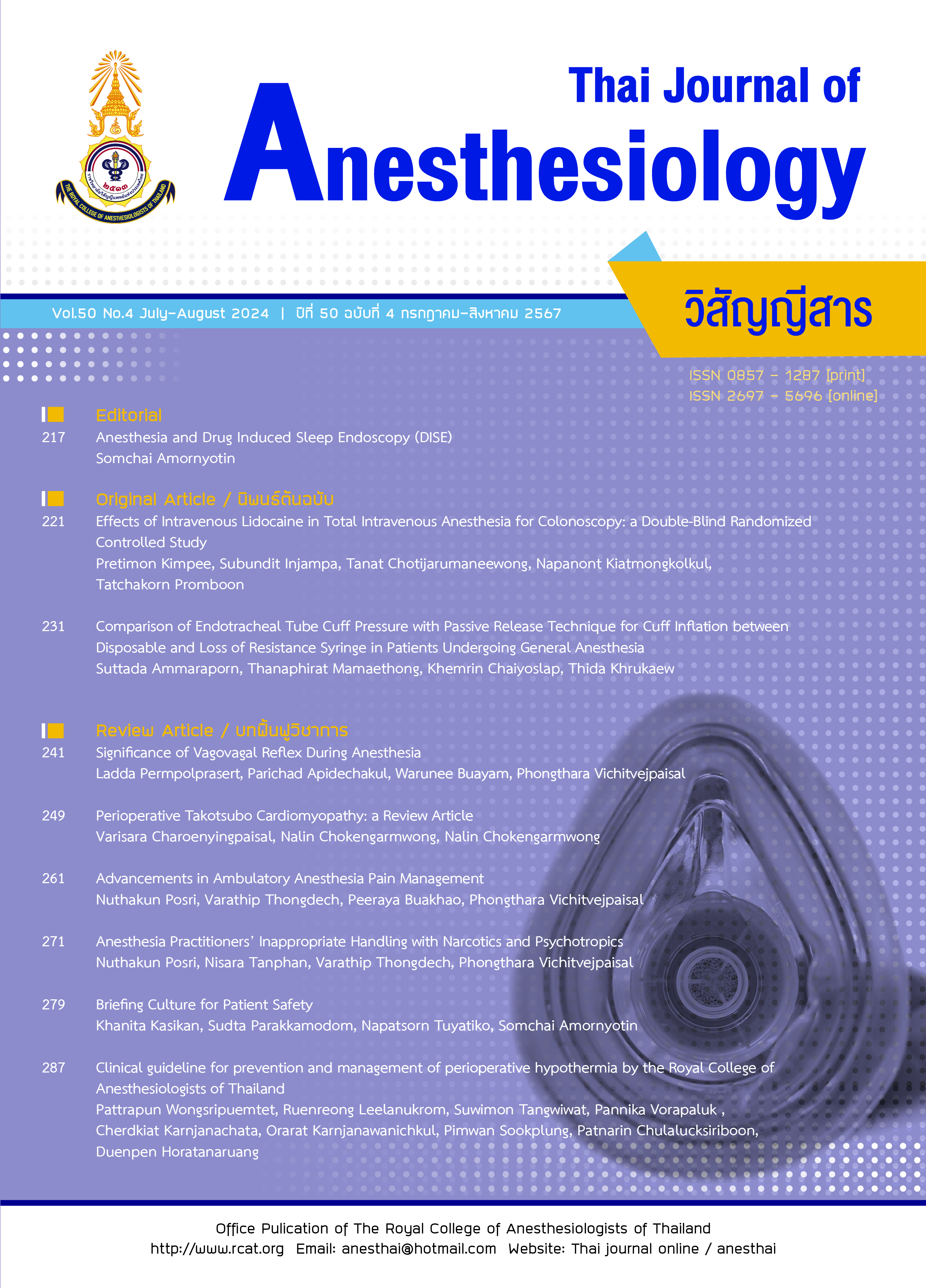Significance of Vagovagal Reflex During Anesthesia
Main Article Content
Abstract
The vagovagal reflex, mediated by the vagus nerve, is a vital mechanism in maintaining homeostasis during anesthesia. This complex reflex involves intricate neural pathways that regulate heart rate, blood pressure, gastrointestinal motility, and respiratory function. Certain anesthetic agents can trigger vagal activation, leading to reflex responses that pose potential complications, including bradycardia, hypotension, bronchospasm and gastrointestinal disturbances. Taking into account factors such as patient age, medical conditions and medication use, a tailored approach can be developed. Proactive and vigilant monitoring of vital signs is essential in detecting and addressing any vagal reflex-mediated changes promptly. Adjusting anesthetic depth, administering intravenous fluids, utilizing pharmacological interventions and employing positive pressure ventilation techniques are effective strategies to counteract vagal reflex responses. Ongoing research efforts aim to further understand the vagovagal reflex and develop improved strategies for its management during anesthesia.
Article Details

This work is licensed under a Creative Commons Attribution-NonCommercial-NoDerivatives 4.0 International License.
References
Jang YE, Do SH, Song IA. Vasovagal cardiac arrest during spinal anesthesia for cesarean section-a case report. Korean J Anesthesiol. 2013;64:77-81.
Powley TL. Brain-gut communication: vagovagal reflexes interconnect the two “brains”. Am J Physiol Gastrointest Liver Physiol. 2021;321:G576-87.
Ahmed U, Chang YC, Zafeiropoulos S, Nassrallah Z, Miller L, Zanos S. Strategies for precision vagus neuromodulation. Bioelectron Med. 2022;8:9.
Prescott SL, Liberles SD. Internal senses of the vagus nerve. Neuron. 2022;110:579-99.
Capilupi MJ, Kerath SM, Becker LB. Vagus nerve stimulation and the cardiovascular system. Cold Spring Harb Perspect Med. 2020;10:a034173.
Weijs TJ, Ruurda JP, Luyer MD, Nieuwenhuijzen GA, Van HR, Bleys RL. Topography and extent of
pulmonary vagus nerve supply with respect to transthoracic oesophagectomy. J Anat. 2015;227:431-9.
Tao J, Campbell JN, Tsai LT, Wu C, Liberles SD, Lowell BB. Highly selective brain-to-gut communication via genetically defined vagus neurons. Neuron. 2021;109:2106-15.
Campagna JA, Carter C. Clinical relevance of the Bezold-Jarisch reflex. Anesthesiology. 2003;98:1250-60.
Kumar A, Goyal A, Rehman F, Hariharan U. Vagal stimulation causing intra-operative cardiac arrest, a major dilemma whether to proceed or to defer surgery: a case report. Explor Res Hypothesis Med. 2023;8:77-80.
Kollarik M, Ru F, Brozmanova M. Vagal afferent nerves with the properties of nociceptors. Auton Neurosci. 2010;153:12-20.
Garcia D, Kehar M, Khan ES, Mendonca R, Girshin M. Multiple episodes of severe bronchospasm during general anesthesia: a case report. Cureus. 2022;14:e21521.
Hunt EB, Sullivan A, Galvin J, MacSharry J, Murphy DM. Gastric aspiration and its role in airway inflammation. Open Respir Med J. 2018;12:1-10.
Mulkey SB, du Plessis AJ. Autonomic nervous system development and its impact on neuropsychiatric outcome. Pediatr Res. 2019;85:120-6.
Mahender A, Chavan SS, Saroa R, Chauhan M. Recent advances in geriatric anaesthesia. Indian J Anaesth. 2023;67:152-8.
Arnold AC, Ng J, Lei L, Raj SR. Autonomic dysfunction in cardiology: pathophysiology, investigation, and management. Can J Cardiol. 2017;33:1524-34.
Lu KH, Cao J, Oleson S, et al. Vagus nerve stimulation promotes gastric emptying by increasing pyloric opening measured with magnetic resonance imaging. Neurogastroenterol Motil. 2018;30:e13380.
Sayyadi S, Raoufi M, Dolatabadi AA, Rostami M, Memary E. Ultrasonographic assessment of metoclopramide administration effectiveness in accelerating gastric emptying before urgent surgery in patients with insufficient NPO time. Anesth Pain Med. 2020;10:e107331.
Dabbous AS, Baissari MC, Nehme PW, Esso JJ, Abu Leila AM. Perioperative reflex bradycardia and cardiac arrest. Middle East J Anaesthesiol. 2014;22:353-60.
Haahr-Raunkjaer C, Molgaard J, Elvekjaer M, et al. Continuous monitoring of vital sign abnormalities; association to clinical complications in 500 postoperative patients. Acta Anaesthesiol Scand. 2022;66:552-62.
Eis S, Kramer J. Anesthesia inhalation agents
and their cardiovascular effects. 2022 Jun 4. In: StatPearls. Treasure Island (FL): StatPearls
Publishing; 2023.
Pathan H, Williams J. Basic opioid pharmacology: an update. Br J Pain. 2012;6:11-6.
Yun Y, Cao D, Zhang X, et al. Glycopyrrolate versus atropine for preventing bradycardia induced by neostigmine injection after general anesthesia surgery: a randomized open, parallel-controlled multicenter clinical trial. Am J Transl Res. 2021;13:12996-13002.
Doukky R, Bargout R, Kelly RF, Calvin JE. Using transcutaneous cardiac pacing to best advantage: how to ensure successful capture and avoid complications. J Crit Illn. 2003; 18:219-25.
Valverde A. Fluid resuscitation for refractory hypotension. Front Vet Sci. 2021;8:621696.
Travagli RA, Anselmi L. Vagal neurocircuitry and its influence on gastric motility. Nat Rev Gastroenterol Hepatol. 2016;13:389-401.
Scullion JE. The development of anticholinergics in the management of COPD. Int J Chron Obstruct Pulmon Dis. 2007;2:33-40.
Chapleau MW, Sabharwal R. Methods of assessing vagus nerve activity and reflexes. Heart Fail Rev. 2011;16:109-27.


